2021.06.02.5
Files > Volume 6 > Vol 6 No 4 2021 > Vol 6 No 2 2021
INVESTIGATION / RESEARCH
Benthic polychaete off Tanintharyi Island, Myeik Archipelago

Zarni Ko Ko1 and Hnin Pwint Htwe2
Available from: http://dx.doi.org/10.21931/RB/2021.06.02.5
ABSTRACT
The survey examined shallow to deep-sea benthic data on benthic fauna from the Myanmar coastal region's northern sector. Benthic samples were collected from 17 stations (26-1500m depth) off Taninthayi Island during the Mayanmar ecosystem survey of the R/V Dr. Fridtjof Nansen Research Vessel. Polychaete (25 taxa in total) had a higher proportion than other groups of benthic fauna. The range of species diversity and evenness were insignificantly different, but species richness differed. The highest species diversity, species evenness, and richness were showed in shallow areas (26 m depth).
Keywords: Diversity indices, Polychaetes, Taninthayi Island, Myeik Archipelago.
INTRODUCTION
Polychaete is part of the old, a group that is longer than full and non-vertebrate. The polychaetes are multi-segment annelids with parapodia; setae are present in distinct fascicles. They are dioecious and have simple existing ducts from the gonads. They are usually marine, rarely fresh-water, and only rarely terrestrial or parasitic in their habitat. Any of these features needed not is present, and none of them is essential for the recognition of an animal as a polychaete.
Polychaetes are the dominant macrofaunal taxa in all marine silt from the intertidal region down to the deep ocean. They constitute more of the entire microbenthic creatures in terms of the number of species and individuals. The lion's share of the species is minimal and short-lived, showing a tall auxiliary generation. Consequently, they are a primary connection in marine nourishment networks and highlight necessarily within the diets of numerous bottom-feeding angles.
Being small-sized life forms, they play a pivotal part in biology and Environmental Impact Assessment (EIA) ponders. As numerous polychaetes are inactive, changes in their wealth and differences have been utilized in natural checking, especially in evaluating the estuaries' wellbeing.
The present survey area, Tanintharyi Island, Myeik Archipelago, is located in the Southern part of the Myanmar Coastal Region. This benthic survey was the preliminary survey of the R/V Dr. Fridtjof Nansen Research Vessel in the Myanmar Coastal Region. Myeik coastal area is rich in many economically important fish, shrimps, oysters, clams, and mussels. Man eats the flesh of many species.
Benthic animals are four groups, namely polychaetes, crustaceans, echinoderms, and mollusks. So, the R/V Dr. Fridtjof Nansen Research Vessel was conducted in Tanintharyi Island, Myeik Archipelago. Cherry Aung1 initiated the earliest study of marine benthos of the Myanmar Coast. She studied the subtidal benthos of Myanmar shelf waters. In 2011, Si Thu Hein2 study polychaetes from three Intertidal Mud Flat stations of Myeik Coastal Areas.
And then War War Soe3 also conducted soft-bottom intertidal macrobenthos from along the Coastal Areas of Myeik Archipelago. Moreover, Hlaing Hlaing Htoon4 reported the Dawei point of the Tahnintharyi Coastal Region. This survey's objectives are (a) to identify what types of polychaetes are found in present survey areas and (b) to analyze the diversity indices of polychaetes of Tanintharyi Island.
MATERIALS AND METHODS
The study area, Tanintharyi Island, Kyunsu Township, Tanintharyi Region, is located between Lat. 12̊ 50′ N & 10̊ 10′ N and Long. 98̊ 15′ E & 97̊ 50′ E. Samples of polychaetes were taken in June 2015 onboard the R/V Dr. Fridtjof Nansen Research Vessel on the parts of northern Myeik Archipelago. On 17 transactions, bottom sediments were sampled at depths of 26m, 43m,44m, 46m, 53m, 60m, 100m, 106m, 220m, 245m, 249m, 252m, 295m, 341m, 500m, 1000m, and 1500m (Table 1). The samples were taken with wire mounted Van Vee Grab, washed with sea-water in these two drawers, which included 5 mm sieve and 0.5 or 0.3 mm sieve and preserved by 4-8 % formalin or 96 % ethanol with 1 spoon of borax powder and put them into the 1-liter bottles. Species diversity indices for each sample were calculated using Shannon and Weaver5, Pielou6, and Margalef' s7. H' =-Pi*lnPi, E' =H'/lnS, D' =S-1/ln N Where, H' is the index of species diversity, Pi is the population abundance of ith species calculated by ni/N, ni is the number of individual of the ith species, N is the total number of individuals in a station, E' is the index of species evenness, S is the total number of species and D' is the index of species richness.
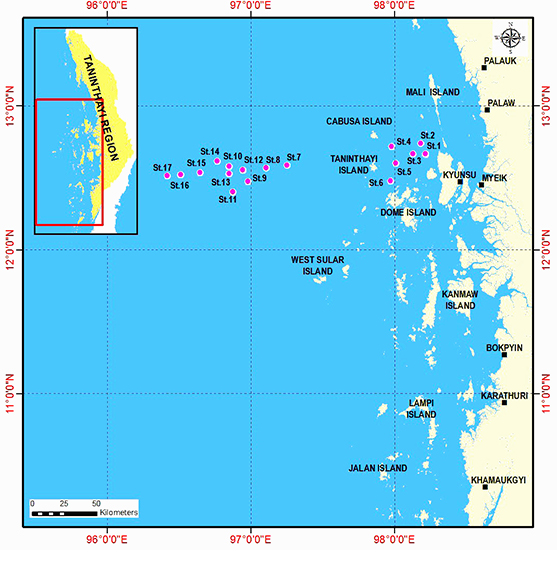
Figure 1. Showing the sampling sites of the Taninthayi Island, Tanintharyi Coastal Region
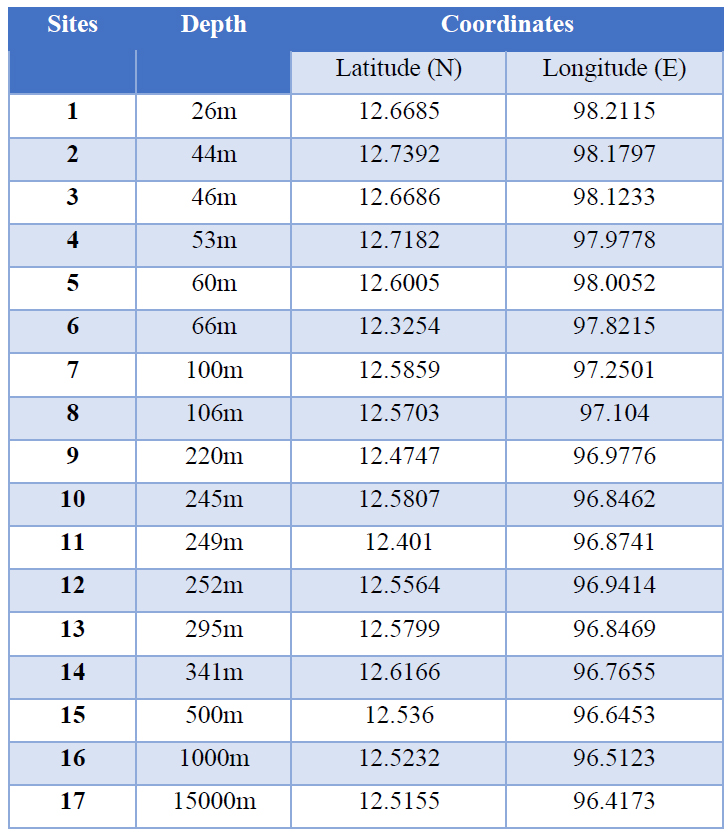
Table 1. Sampling sites of the station Tanintharyi Island, Tanintharyi Coastal Region
RESULTS AND DISCUSSION
A total of 25 genera of Polychaetes were recorded in the present study; 1 genus from Ampharetidae, 1 genus from Hesionidae, 3 genera from Capitellidae, 1 genus from Sabellariidae, 2 genera from Eunicidae, 1 genus from Lumbrineridae, 1 genus from Glycerida, 1 genus from Nephtyidae, 1 genus from Nereidae, 1 genus from Phyllodocidae, 2 genera from Polynoidae, 1 genus from Sabellidae, 1 genus from Sabellaridae, 1 genus from Maldanidae, 1 genus from Orbiniidae, 1 genus from Paraonidae, 1 genus from Poecilochaetidae, 2 genera from Spionidae, 1 genus from Flabelligeridae, 1 genus from Terebellidae were described.
About 25 polychaete species were identified from the studied areas, of which 19 taxa were identified from the shallowest water (26m depth), 4, 4, 1, 2, and 3 taxa of polychaetes from depths 44m, 46m, 53m, 60m, 66m respectively. And only 3 taxa of polychaetes were also identified form eleven sampling sites of deepwater, off Tanintharyi Island, Myeik Archipelago (Table 2). In 2013, 120 species of polychaetes were recorded in soft-bottom intertidal zones of Myeik coastal areas by War War Soe3. Moreover, 31 species of polychaete were observed around the Dawei point, Tanintharyi Coastal Region 4
In the present survey, Notomastus was commonly found at 26m, 44m, 46m, 53m, and 500m depths in shallow and depth-water. Heteromastus was also found commonly at 26m, 46m, and 60m depths, respectively. Paraonis was only occurred at deepwater of 1000m depth. At survey depths; 100m depth (site 7), 220m depth (site 9), 245m depth (site 10), 249m depth (site 11), 252m depth (site 12), 295m depth (site 13), and 341m depth (site 14) were no observed any polychaete taxa. Depth wise taxa composition in Tanintharyi Island was shown in Table 2 and Figure 3.

Table 2. Distribution of polychaetes at all sites of Tanintharyi Island, Tanintharyi Coastal Region.
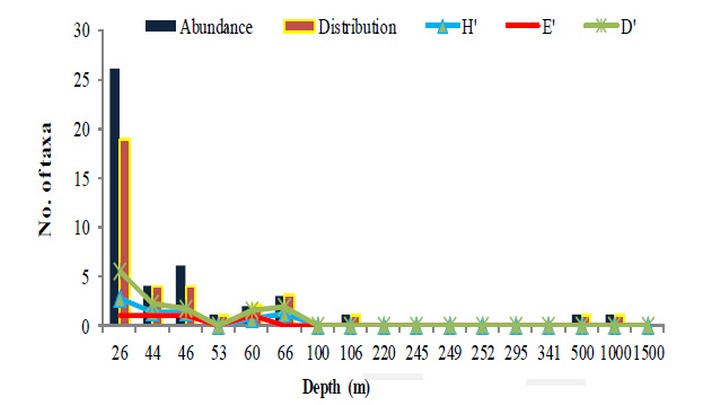
Figure 2. Composition, Abundance, Species Diversity, Eveness and Richness of polychaete in Tanintharyi Island
In the present study, Shannon diversity values for polychaetes were in the range of 0-2.79. The H′ for polychaetes in Myeik Archipelago and Dawei point was the range in 2.26-3.62 and1.83- 2.62 3, 4 respectively. The range of evenness (E′), richness (D′) for polychaetes was 0-1 and 0-5.52, respectively. In Myeik Archipelago, E′ value was the range in 0.74-0.88, and D′ was War War Soe3 reported 2.62-10.55. Moreover, in Dawei's point, the values E′ and D′ were ranged in 0.77-0.88, and 2.33-6.16 was noticed. 4
Low diversity and a higher population density of a few organisms denote stress conditions, which practically eliminate many species but promote a few survival. Contrary to this, high diversity and lesser relative dominance of individual species characterize areas of relative environmental stability. 8 In the present study, benthic production in terms of abundance and number of polychaete genera low in deepwater stations. Low diversity and lower benthic fauna at depth water stations indicate stress conditions because of destructive fishing activities (trawling and purse seining) and dredging. Besides, fishers' fishing activities, especially those living in a coastal area, can damage the bottom communities.
In the present study, high species diversity, species richness, species evenness of polychaetes were noticed at shallow water sites, low species diversity, low richness, and low evenness of polychaetes were noticed in depth beyond 66m. Species diversity index varied between 0.69 and 2.79. Sites 8, 15, and 16 showed the least species diversity of all sites that present only one genus. At stations 4 and 5, only 2 genera were occurred, showing the low richness of 1.44. In the other stations, the index varied from 0 to 5.52. On comparing for species, evenness distribution high values were observed at stations 2, 4, and 5. The study of polychaetes in the area showed a wide variation in distribution, abundance, and composition. This decrease in species richness and diversity of benthic fauna cannot be due to the lack of food, and the only factor that appears to be limiting is dissolved oxygen. 9
The study of benthos in the area showed a wide variation in distribution, abundance, and composition. This may be probably due to various biological and physicochemical environmental factors. Wide fluctuation in salinity and the nature of substratum and organic enrichment in the sediment are the critical factors restricting the abundance of benthos (Sheeba8). The studies by Rosenberg10 and Jones and Candy11 suggested that the benthic fauna of dredged areas differs from that of non dredged areas concerning species composition, abundance, and diversity.
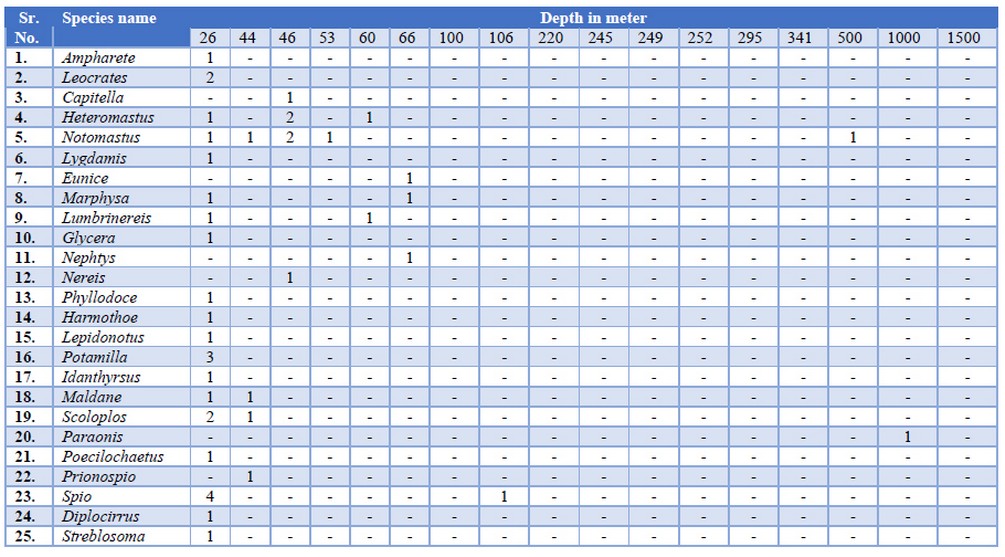 Sr.
Sr.Table 3. Abundance of polychaetes at all sites of Tanintharyi Island, Tanintharyi Coastal Region.
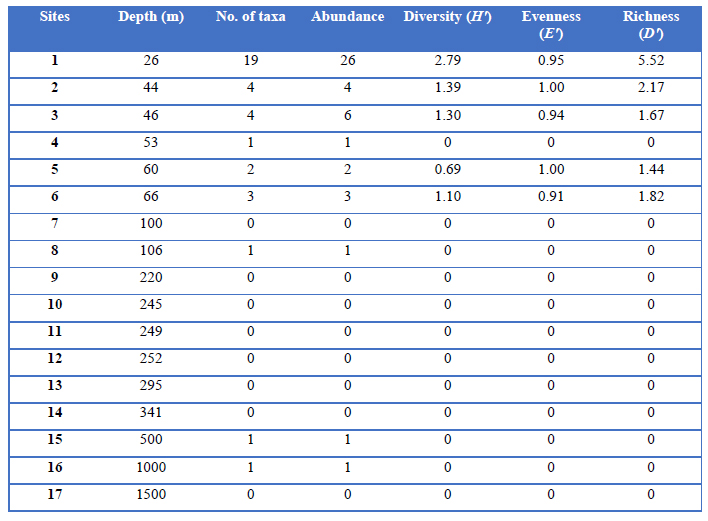
Table 4. Composition, Abundance, Species Diversity, Evenness, and Richness of polychaete inTanintharyi Island, Tanintharyi Coastal Region.
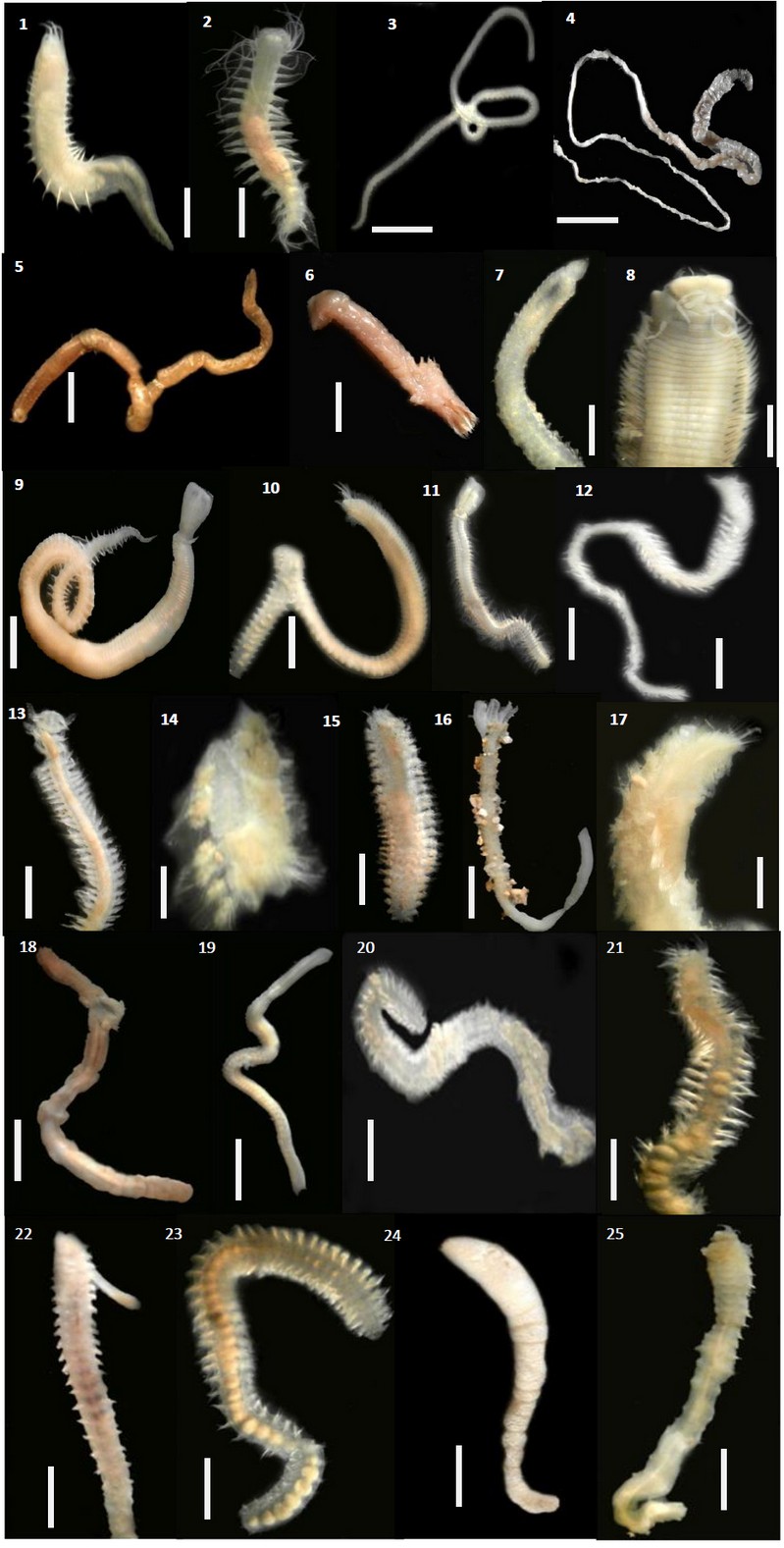
Figure 3. Polychaetes: 1) Ampharete, 2) Leocrates, 3) Capitella, 4) Heteromastus, 5) Notomastus, 6) Lygdamis, 7) Eunice, 8) Marphysa, 9) Lumbrineris, 10) Glycera, 11) Nephtys, 12) Nereis, 13) Phyllodoce, 14) Harmothoe, 15) Lepidonotus, 16) Potamila, 17) Idanthyrsus 18) Maldane, 19) Scoloplos, 20) Paraonis, 21) Poecilochaetus, 22) Prionospio, 23) Spio, 24) Diplocirrus, 25) Streblosoma. Scale bars= 1.5 mm
CONCLUSION
The recorded specimens comprised 25 taxa of polychaetes and some taxa of arthropods. Echinoderm and mollusks were removed because most are dead shells. Among the benthic fauna, polychaetes were the most dominant taxa from the present survey. Site 1 (26m depth) showed the highest abundance of benthic fauna (polychaetes) in terms of number and genera. In the present study, benthic production in terms of abundance and the number of genera low in deepwater stations. It can be stated that low diversity and a lower number of benthic fauna at deepwater stations indicate stress conditions because of destructive fishing activities and dredging. This study supports as baseline data for future monitoring programs in the area.
Acknowledgments
I am thankful to Dr Aung Myat Kyaw Sein, Acting Rector of Mawlamyine University, Dr. San San Aye, Pro-Rector of Mawlamyine University, for their encouragement and supports in preparing this work. I am very grateful to Dr. San Tha Tun, Professor, and Head of the Department of Marine Science, Mawlamyine University, for his valuable suggestions and constructive criticisms on this study. I am really thanks to Hnin Pwint Htwe, Mres, Department of Marine Science, Myeik University, for their assistance during identification and many helps in research works. Thanks are also due to many of Dr Naung Naung Oo and other colleagues in Department of Marine Science, Myeik University and Mawlamyine Unversity for their assistance and encouragement during this research work. Finally, I would like to thank my beloved parents and my dear brother for their physical, moral and financial supports throughout this study.
REFERENCES
- Cherry Aung. (2002). Distribution and abundance of meiofauna in shallow water of North Andaman Sea around Myanmar coast. Unpublished Departmental Research Paper. Department of Marine Science, Mawlamyine University, Myanmar.
- Si Thu Hein. (2011). Study on polychaete diversity in some intertidal mud flat of Myeik area. Unpublished MRes Thesis. Department of Marine Science, Myeik University, Myeik, Myanmar.
- War War Soe. (2013). Ecology of soft-bottom macrobenthic faunal communities in the intertidal zone of Myeik coastal areas. Unpublished PhD Dissertation. Department of Marine Science, Mawlamyine University, Mawlamyine, Myanmar.
- Hlaing Hlaing Htoon (2016). A study on the intertidal benthos around the Dawei point with reference to the polychaetes. Unpublished PhD Dissertation. Department of Marine Science, Mawlamyine University, Mawlamyine, Myanmar.
- Shannon, C. E. and Wiener, W. 1963. The mathematical theory of communication. University of Illinoise. Urban press, Illinoise, USA. 117 pp.
- Pielou, E. C. 1975. Ecological diversity. John Wiley & Sons, INC, New York. 165 pp.
- Margalef, R. 1958. Perspectives in ecological theory. University of Chicago press, USA. 111 pp.
- Sheeba, P. 2000. Distribution of benthic infauna in the Cochin backwaters in relation to environment parameters. Unpublished PhD Thesis. Cochin University of Science and Technology.
- Joydas, T. V. 2002. Macrobenthos of the shelf waters of the west coast of India. Unpublished PhD Thesis. Cochin University of Science and Technology.
- Rosenberg, R. 1977. Effects of dredging operations on estuarine benthic macrofauna. Mar Pollu. Bull. 8 102-105.
- Jones, G. and Candy, S. 1981. Effects of dreding on the macrobenthic infauna of Bontany Bay. Aug. J. Mar. Freshwater Res. 32: 379-398.
Received: 10 November 2020
Accepted: 10 February 2021
Zarni Ko Ko1 and Hnin Pwint Htwe2
1Lecturer, Department of Marine Science, Mawlamyine University, Mon State, Myanmar
https://orcid/0000-0002-6280-5002 Corresponding author: [email protected]
2MRes , Department of Marine Science, Myeik University, Myeik Taninthayi Region, Myanmar